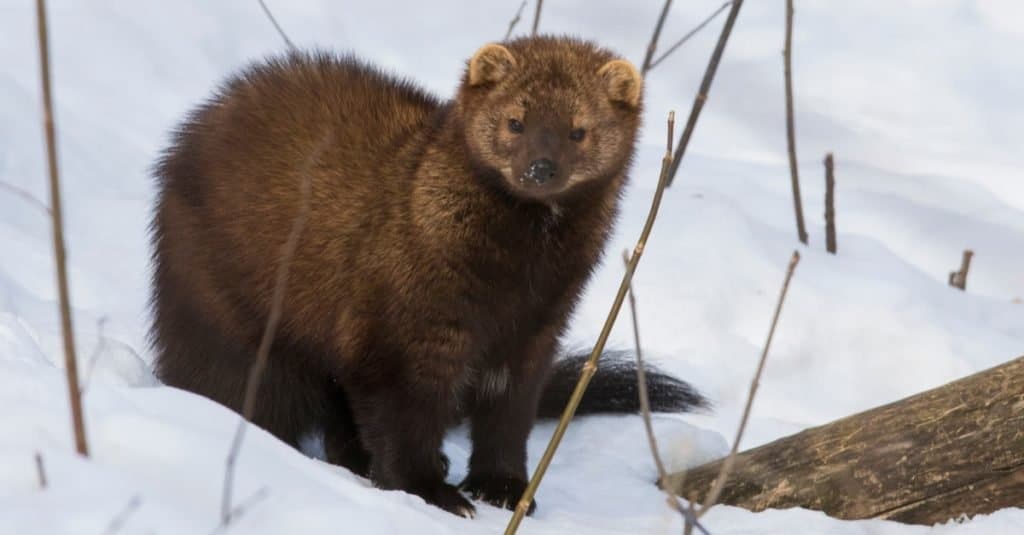Imprints left in sand, mud, and snow tell a story about the animal that walked across the surface. What animals was it? Where did it go? What did it do? What other creatures did it interact with? Researchers use animal tracking to gather data on how species move individually or in a group, where they migrate, and how they’ve evolved across generations. But hunters and naturalists also track footprints to identify which animals are in the area. And if you own property where an unknown animal has crossed, you are probably curious about its identity, too.
Use this fisher tracks identification guide to learn about this animal’s footprint appearance in snow, mud, and sand.
What is a Fisher?

Fishers are small mammals that live in the boreal forests of Canada and the United States.
©Reimar/Shutterstock.com
Fishers are small mammals from the weasel family, meaning they are related to otters and martens. They are around the size of a large house cat and feature long torsos, long, bushy tails, and sleek, dark brown coats. These nocturnal creatures live in the boreal forests of Canada and the Northern United States. They prefer continuous forests, where they spend much of their time on the ground or climbing trees. Fishers like course, woody forest floors and tend to avoid deep snow, if possible. They range across much of Canada, as far north as the Northwest Territories. In America, they occur as far south as Oregon through New England and down to Virginia.
Fishers have a complicated history with humans. They were hunted and trapped for pelts as early as the 18th century. Due to their fur being in high demand, their populations were decimated from several parts of the United States. While these animals tend to avoid humans, spottings do occur when people encroach on their forest habitats. Fishers don’t typically attack humans unless they feel threatened or cornered.
Fisher Tracks Identification: What Do Fisher Tracks Look Like?

Fisher tracks have five toes and a distinct c-shaped metacarpal pad. There is also negative space between the pad and the digits.
©Abigail Crawford/Shutterstock.com
One of the most telling signs of following fisher tracks is the varied journey they take you on. These animals do a lot of activity within a short period. They wind through the forest, stop to smell and look for food, climb up trees, and kill small animals.
Fishers have five clawed toes, with the first innermost digit to the rear smaller than the others. While the fifth digit can help you identify this species, the innermost toe doesn’t always register unless it’s a really good, clear print. These mustelids also have muted paw prints due to their heavily furred feet. Sometimes, you may not be able to make out the toes clearly. But the pads of their feet are often distinct, especially the C-shaped metacarpal. You will see blank space between the C-shaped pad and the toes because of its fur. Also, its hind tracks are somewhat smaller than its front feet. You may find all four feet planted near each other when the animal stops.
| Category | Information |
|---|---|
| Size | Body is 2 to 3 feet long. Front feet are 2 to 4 inches wide. Hind feet are 1.5 to 3.5 inches wide. |
| Shape | Oval |
| Digits | Five digits. But only four may be visable. |
| Other Discernible Features | C-shaped metacarpal pad with black space before reaching the digits |
The difference in Fisher Tracks in Snow, Mud, and Sand

In light snow with dry, powdery conditions, you can usually get a distinct print, with all toes present.
©Mircea Costina/Shutterstock.com
While fisher tracks can look similar in all terrain, there are certain differences you can look for. For instance, in deep snow, fishers use a 2X2 gait. They place their two front feet together, with one somewhat ahead. Then with the hind legs together, they place them directly in the same spot where the front feet just were. This unusual walk helps them traverse the land, especially with their long torsos and short legs. In light snow with dry, powdery conditions, you can usually see a distinct print, with all toe indentions present. But the toe tracks can be even more clear when the snow is sticky.
Fisher tracks in mud and sand tend to be more pronounced than what you would find in the snow. Because of this, you will have an easier time identifying this animal. The fifth digit should be visible, along with the metacarpal pad. You can also clearly see their specific gait, which is more likely to be an alternating walk or rotary lope.
Read these articles next about raccoon tracks and wolverine tracks.
The photo featured at the top of this post is © Holly Kuchera/Shutterstock.com
Thank you for reading! Have some feedback for us? Contact the AZ Animals editorial team.







